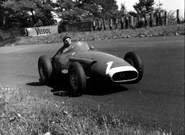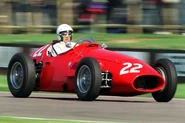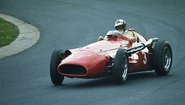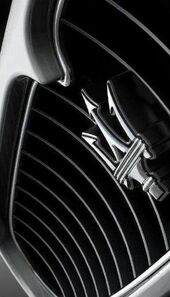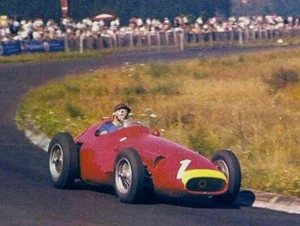
| |
| Maserati 250F | |
|---|---|
| Maserati | |
| aka | |
| Production | |
| Class | Formula One |
| Body Style | 1-seater |
| Length | |
| Width | |
| Height | |
| Wheelbase | |
| Weight | |
| Transmission | 1954: Maserati 4 speed manual 1956: Stirnsia 5 speed manual |
| Engine | 2.5 litre Maserati normally aspirated straight 6 3.5 litre naturally aspirated V12 |
| Power | 220 bhp @ 7400 rpm 315 hp (V12) |
| Similar | |
| Designer | Gioacchino Colombo Valerio Colotti |
The Maserati 250F (first raced January 1954 - last raced November 1960) was a racing car made by Maserati of Italy, used in '2.5 litre' Formula One racing (thus, the '250' and 'F'). 26 examples were made in total. It was introduced for the 1954 Formula One season and remained in use by customer teams until 1960.
Mechanical details[]
It mainly used the Maserati A6 SSG straight-six 2.5-litre engine (220 bhp @ 7400 rpm), ribbed 13.4" drum brakes, wishbone independent front suspension and a De Dion tube axle. It was built by Gioacchino Colombo, Vittorio Bellentani and Alberto Massimino; the tubular work was by Valerio Colotti, then working for Maserati.
A streamlined version with bodywork which partially enclosed the wheels (similar to the 1954 Mercedes-Benz W196 "Typ Monza") was used in the 1956 French Grand Prix.[1]
Racing history[]
The 250F first raced in the 1954 Argentine Grand Prix where Juan Manuel Fangio won the first of his two victories before he and Stirling Moss left for the new Mercedes-Benz team. Fangio won the 1954 Drivers' World Championship, with points gained with both Maserati and Mercedes-Benz.
Although Bellentoni and Massimino left for Ferrari, 1955 saw a setup with 5-speed gearbox as well as SU fuel injection (240 bhp) and Dunlop disc brakes. Jean Behra ran this in a five-member works team which included Luigi Musso.
In 1956 Stirling Moss won at the Italian Grand Prix and the Monaco Grand Prix in his private car.
In 1956 three 250F T2 cars first appeared for the works drivers. Developed by Giulio Alfieri using lighter steel tubes they sported a slimmer, stiffer body and sometimes the new 315 bhp V12 engine, although it little or no real advantage over the older straight 6. It was eventually reused in the unsuccessful 1966 F1 Cooper Maserati.
In 1957 Juan Manuel Fangio drove to four more championship victories, including his legendary final win at German Grand Prix at the Nürburgring (Aug. 4, 1957), and his final race at the French Grand Prix.
The Constructors' World Championship was introduced in 1959, by which time the 250F was generally outclassed. However, the car remained a favourite with the privateers, including Maria Teresa de Filippis and was used until 1960.
In total, the 250F competed in 46 Formula One championship races with 277 entries, leading to eight wins.
Photos[]
Drivers[]
- 1954: Juan Manuel Fangio, Onofre Marimon, Stirling Moss, Prince Bira, Sergio Mantovani, Luigi Villoresi, Ken Wharton, Roy Salvadori, Alberto Ascari, Roberto Mieres, Harry Schell, Louis Rosier
- 1955: Jean Behra, Luigi Musso, Clemar Bucci, Carlos Menditeguy, Cesare Perdisa, Lance Macklin, Johnny Claes, Horace Gould, Peter Walker, Peter Collins, Andre Simon, John Fitch
- 1956: Mike Hawthorn, Chico Landi, Gerino Gerini, Luigi Piotti, Jose Froilan Gonzalez, Louis Chiron, Francisco Godia-Sales, Piero Taruffi, Bruce Halford, Umberto Maglioli, Jack Brabham, Emmanuel de Graffenried, Jo Bonnier
- 1957: Masten Gregory, Giorgio Scarlatti, Hans Herrmann, Ivor Bueb, Ottorino Volonterio
- 1958: Ken Kavanagh, Luigi Taramazzo, Maria Teresa de Filippis, Andre Testut, Maurice Trintignant, Wolfgang Seidel, Phil Hill, Troy Ruttman, Carroll Shelby, Cliff Allison, Giulio Cabianca
- 1959: Carel Godin de Beaufort, Fritz d'Orey, Astrubel Bayardo, Phil Cade
- 1960: Ettore Chimeri, Antonio Creus, Bob Drake
Literature[]
- David McKinney, Maserati 250F,
References[]
- ↑ Grand Prix Data Book, David Hayhoe & David Holland, 2006
